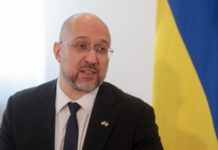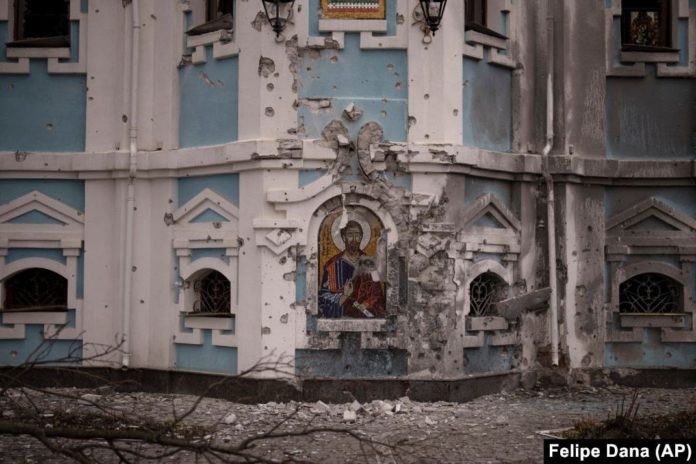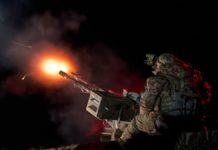Day 1146 of the full-scale invasion
As of April 20, 2025, the situation on the front lines remains especially tense, particularly in the east. Russian forces continue attempts to regain tactical initiative by launching waves of assaults near Chasiv Yar, Avdiivka, and Kupiansk. Ukrainian forces are holding the line while striking at the enemy’s logistics. Meanwhile, international pressure on Russia is intensifying, and new support formats for Ukraine are being discussed.
Frontline Situation
According to the General Staff of the Armed Forces of Ukraine, 102 combat engagements were recorded over the past 24 hours.
- Kharkiv axis: Russian forces conducted unsuccessful assaults near Vovchansk, Strilecha, and Lyptsi. Ukrainian artillery struck enemy positions, destroying two ammunition depots.
- Kupiansk axis: Intense attacks were observed near Synkivka, Ivanivka, and Pershotravneve. Ukrainian defenders repelled the assaults and destroyed several armored vehicles.
- Lyman axis: Russian troops attempted assaults near Nevske, Torske, and Terny, all of which were repelled by Ukrainian artillery.
- Bakhmut axis: Fierce battles continue around Chasiv Yar, with Russian infantry attacks supported by air power.
- Avdiivka axis: Combat is ongoing near Semenivka, Sieverne, and Tonenke, with Russian forces suffering heavy losses.
- Marinka axis: Russian assaults near Krasnohorivka and Novomykhailivka failed.
- Zaporizhzhia axis: Artillery duels continue near Robotyne, Verbove, and Novodanylivka. Russian sabotage groups are active.
- Kherson axis: Ukrainian forces maintain positions on the Dnipro’s left bank, using FPV drones to destroy enemy equipment.
Ukrainian forces retain strategic initiative, effectively deploying mobile strike groups, precision artillery, and advanced drones.
Russian Losses
As of the morning of April 20, 2025, the General Staff of the Armed Forces of Ukraine reports Russia’s total estimated combat losses as follows:
- Personnel — 941,100 (+950)
- Tanks — 10,677 (+1)
- Armored combat vehicles — 22,271 (+5)
- Artillery systems — 26,649 (+49)
- MLRS — 1,368 (+0)
- Air defense systems — 1,139 (+0)
- Aircraft — 370 (+0)
- Helicopters — 335 (+0)
- Tactical UAVs — 33,240 (+64)
- Cruise missiles — 3,148 (+0)
- Warships / boats — 28 (+0)
- Submarines — 1 (+0)
- Vehicles and tankers — 45,274 (+112)
- Special equipment — 3,859 (+1)
The scale of Russian losses remains record-high in 2025, indicating the critical depletion of enemy resources and the effectiveness of Ukraine’s sustained strategy to systematically dismantle Russia’s combat capabilities.
Ukrainian Strikes and Achievements
Ukrainian Defense Forces continue to target Russian logistics and command points with precision:
- A field ammunition depot was destroyed near Sloviansk in Donetsk Oblast.
- Special Forces struck a command post in Kherson Oblast, eliminating at least seven Russian troops.
- Ukrainian air defense shot down two Orlan-10 drones in the south.
- FPV drones destroyed two armored vehicles and an electronic warfare system near Avdiivka.
- Artillery forces struck a convoy of Russian trucks transporting ammunition near Kupiansk.
The Ukrainian Armed Forces demonstrate high efficiency in neutralizing critical enemy assets, including logistics hubs, equipment, and command infrastructure.
Diplomatic Initiatives and Negotiations
In April 2025, diplomatic efforts to end the war in Ukraine intensified, although they remain complex and controversial.
- Easter Truce: On April 19, Russia announced a unilateral 30-hour Easter ceasefire. However, Ukraine reported continued Russian shelling in Kherson, Donetsk, and Luhansk regions. President Volodymyr Zelensky called it an “information operation” and proposed extending the ceasefire to 30 days, contingent on full cessation of hostilities.
- UK Position: The UK Foreign Office urged Russia to implement a full ceasefire, highlighting that Ukraine had already agreed to such a truce. The UK emphasized the need for serious Russian engagement to achieve a just peace.
- Paris Talks: High-level negotiations took place in Paris with participation from the US, France, the UK, and Ukraine. President Emmanuel Macron referred to them as a diplomatic breakthrough. Discussions focused on security guarantees, including a potential international peacekeeping mission.
- US Position: President Donald Trump and Secretary of State Marco Rubio warned that the US might withdraw from peace efforts if no progress is made within days. This raised concerns among European allies about US consistency.
- Coalition of the Willing: The UK and France are leading a coalition of over 30 countries prepared to enforce a future peace deal in Ukraine, including the deployment of peacekeeping forces.
Overall, diplomatic efforts continue but are hindered by a lack of trust and diverging visions for ending the war.
International Support for Ukraine
As diplomacy intensifies, Ukraine is receiving concrete signals of continued support from its allies:
- Canada: In January 2025, Canada announced a military aid package worth CAD 440 million, with CAD 200 million allocated to the Czech-led initiative to procure large-caliber ammunition.
- Spain: Plans to supply 4 to 6 Leopard 2A4 tanks to Ukraine, depending on the technical condition of stored equipment in Zaragoza.
- Norway: Engaged in talks with Ukraine on joint production of new missiles for NASAMS air defense systems.
- Latvia: Delivered 1,500 combat drones as part of the international drone coalition.
Key partners are demonstrating not only political support but also tangible action to bolster Ukraine’s defense capabilities during a critical phase of the war.
Humanitarian Situation in Ukraine
Civilian infrastructure remains under constant threat from Russian attacks:
- Two civilians were killed and six injured in Kherson due to Russian shelling.
- Drone strikes damaged energy infrastructure in Dnipro.
- Rocket artillery damaged schools in Sumy Oblast.
- Over 300 tons of humanitarian aid were delivered to front-line areas in Donetsk and Zaporizhzhia by international organizations.
- Partial restoration of electricity was completed in Odesa following recent strikes.
Russia continues to deliberately target critical infrastructure, worsening the humanitarian crisis in regions close to the front.
Domestic Situation in Ukraine
Ukraine continues to adapt its institutions to the conditions of prolonged war:
- Parliament passed the first reading of a new mobilization law enhancing draft records and expanding eligibility.
- The Cabinet approved a support program for volunteer organizations in front-line communities.
- The Ministry of Health launched the “Mobile Medicine” initiative — over 60 mobile clinics are now operating in combat-affected regions.
- The National Bank of Ukraine reported GDP growth of 2.7% in Q1 2025, indicating early signs of stabilization.
Despite the difficult security environment, Ukraine continues structural reforms in defense, healthcare, and the economy.
Conclusion
April 20 was marked by intensified fighting in Donetsk and Kharkiv regions and continued heavy Russian losses. Ukraine maintains the initiative, striking logistics and command centers. International support remains steady both diplomatically and militarily. Domestically, Ukraine advances essential reforms and strengthens cooperation with civil society in adapting to protracte conflict.
🤝 SUPPORT US 💙💛
We continue to work only because you read and support us. If you appreciate what we do, please become our sponsor or donate here👇
☕️ buymeacoffee.com/meaninuak
or
☑️ patreon.com/MeanwhileinUkraine
Your support helps us continue delivering timely and accurate updates. Stay informed and stand with Ukraine! 🇺🇦
Together we are stronger! 🇺🇦
























